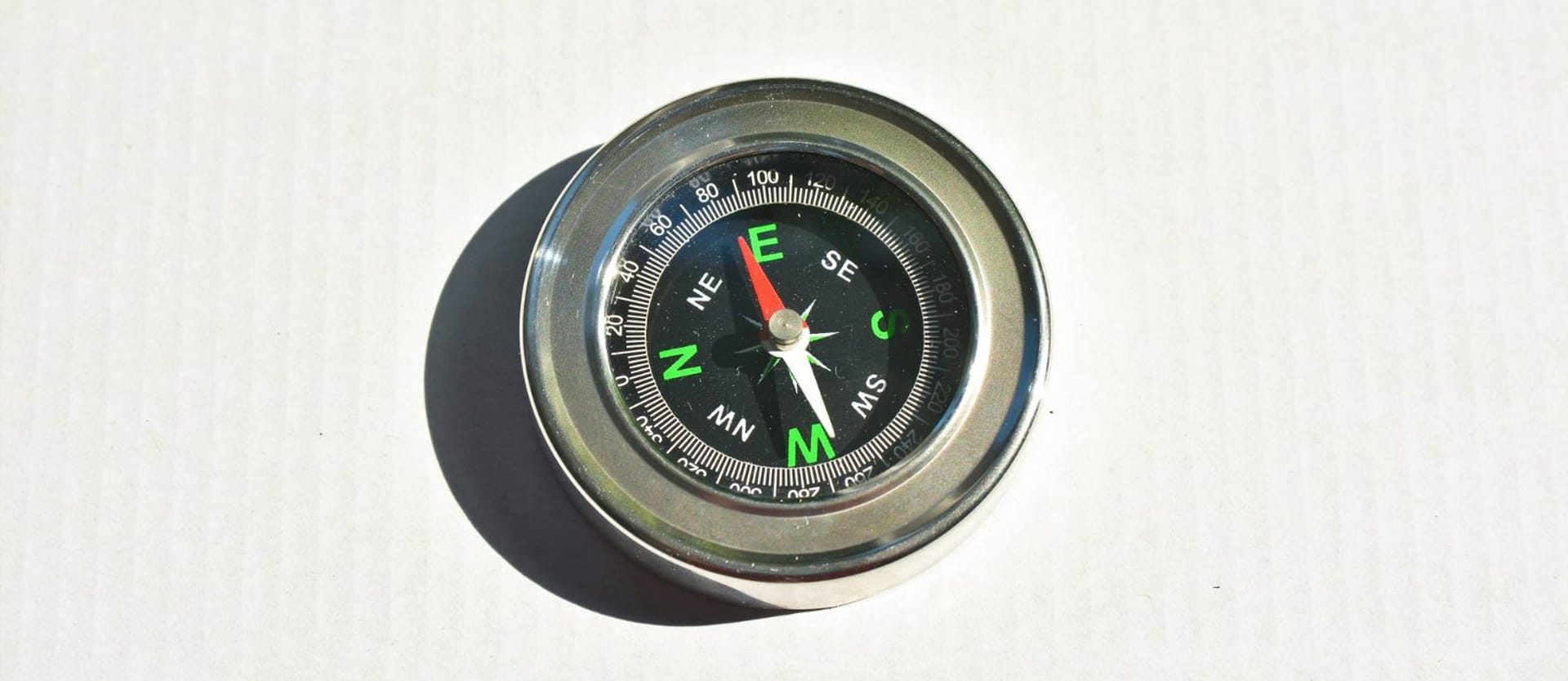What do you need to create a product? First, an idea of how it will look in the end. Then follows a process of product creation that takes a lot of time, effort, a team of professionals, and a team leader. To transform any idea into a profitable product, a company has to go through several stages to set a vision, define a strategy, develop a product, and sell it to the right people.
This article examines the product manager's responsibilities, the process of product management and its main stages, the different roles in a product team, and how to become a product manager.
What is product management?
Product management is a process that focuses on bringing a new product to market or enhancing an existing one. It starts with an idea that a customer will interact with and ends with evaluating the product’s success. Product management unites business, product development, marketing, and sales. Studies show that effective product management can increase profit by 34.2 percent.
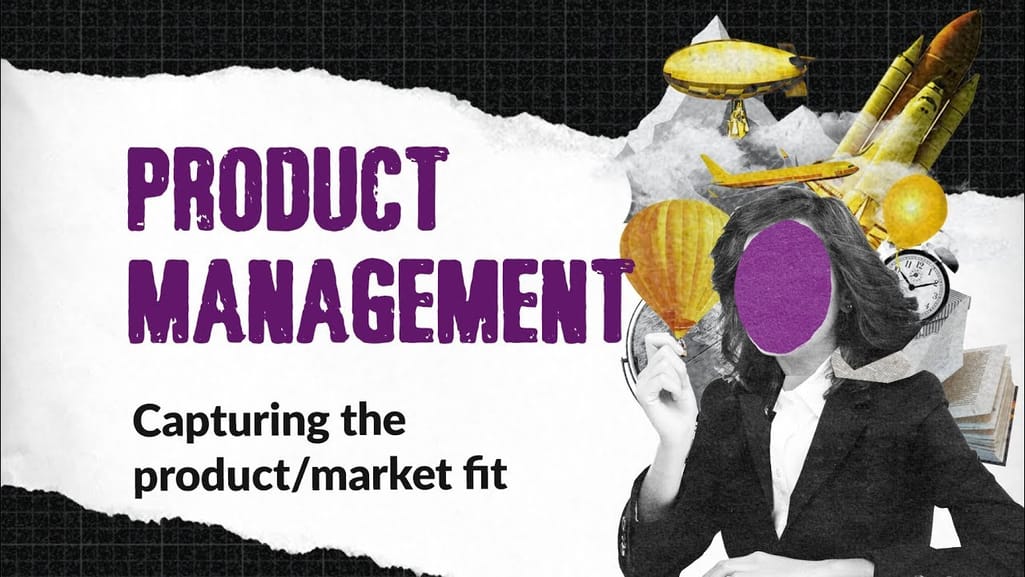

Product management in software development, explained
Product management vs. project management
The confusion between the concepts of project management and product management is fairly common. Let's clear things up and discuss the differences.
Project management centers around a particular phase of the product life cycle—product development. A project manager organizes all the internal processes involved in product development while ensuring adherence to timelines and budgets. Their role involves tracking progress and coordinating resources, which includes team members (engineers and designers), to ensure the timely delivery of the product.
On the other hand, product management extends beyond a specific phase. Product managers oversee the entire journey of a product from conception to launch. They focus on features, business value, and the customer. In this role, responsibilities are more high-level, involving setting the overall vision, developing a strategic plan, and identifying and prioritizing requirements.
Agile product management
Agile development employs dynamic and flexible methodologies for planning and delivering products. In this approach, cross-functional teams collaborate, aligning their efforts to achieve the overarching product goals. The key characteristics of agile development include breaking down the scope into iterations (sprints), short time-to-market for each product increment, and continuous product improvements based on feedback gained from the market.
This emphasis on short customer feedback loops allows product managers to adapt the product strategy and make adjustments based on insights gained after each release. This fosters a responsive and customer-centric development process. In fact, all product management activities we discuss below thrive within agile development.
Product management examples
Let's look at some practical examples of problems and tasks product management helps address.
Product discovery. Discovery is a process of finding customer’s problems that the future or the current product can solve. Product managers help with market research, learning about customer pain points, and converting them into product ideas. As a part of discovery, product managers can oversee prototyping, building MVPs, running customer interviews, etc.


Product discovery explained
Strategic leadership in software development. Product managers define the vision, gather user feedback, and oversee the development process to ensure the final product meets user needs and market demands. This is integral when creating standalone applications, web and mobile-device applications, and Software as a Service (SaaS) platforms.
Improving user experience and usability of products.. Product managers prioritize features that enhance usability, working closely with development and marketing teams to create an intuitive user experience.
Legacy system modernization. When modernizing legacy products, product managers help understand user expectations and ensure a smooth transition. They focus on maintaining the core values of legacy products.
Team leadership. Product managers may streamline communication and enhance teamwork.
Who is a product manager?
A product manager is a person who creates internal and external product vision and leads product development from scratch. This individual defines customer needs, works with stakeholders and teams to create the required product, and carries responsibility for overall product success.
What a product manager does
Marty Cagan, the author of Inspired: How to Create Products Customers Love, says the definition of the goal of a product manager is “to discover a product that is valuable, usable, and feasible.” So, a product manager has to be knowledgeable in three main spheres: business, technologies, and user experience.
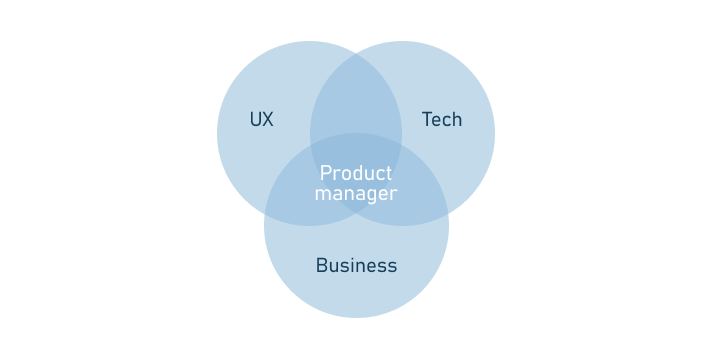
Who is a product manager?
Identifying opportunities. The first thing a product manager does is look for the opportunity to develop a new successful product or improve an existing one by adding necessary features. The expert must be aware of current trends and have a deep understanding of the market. This person is also responsible for the outcome of a product launch.
Developing product vision and strategy. A product manager defines the long-term mission of a project and builds a clear, realistic plan of how to reach the desired result. Feedback Loop’s survey demonstrated that the key activity of most product managers (84 percent) is setting a product strategy. It’s closely followed by crafting a clear roadmap and overseeing its completion.
When the strategy is ready, the product manager communicates it to the product team and the stakeholders.
Team and stakeholder management. A product manager makes sure that all members of a team work in harmony to achieve the main goal. One of the most important functions of this person is to clearly communicate the requirements to the development team and organize the development process in the most efficient way. On the other hand, the product manager negotiates with stakeholders and balances their demands and expectations.
Stakeholders greatly influence product development because they can cut the budget or change the timeline. They can suggest implementing product features they find necessary, which, in reality, can be completely useless to end customers. The product manager's task is to ensure a common understanding of the vision.
Marketing activities. Marketing is one of the main factors contributing to product success, so product managers collaborate with product marketing managers. That involves market research, observing current industry trends, collecting and analyzing customer feedback, defining pricing, and developing a marketing strategy.
Constant product improvement. While at first glance it seems a product manager only performs administrative tasks, that is not true. They are constantly working on improving the existing product, testing it, analyzing data, and managing defects. Eventually, a product manager makes the final decision on what the end product should be like.
While there’s no single set of key performance indicators (KPIs) and responsibilities for a product manager, they usually include monetization, user engagement, and user satisfaction. The KPIs may vary depending on the company and industry. Some product managers focus mainly on development, writing software requirements specifications, and supervising project progression. Others concentrate on marketing and sales, creating a marketing plan, and training a sales team.
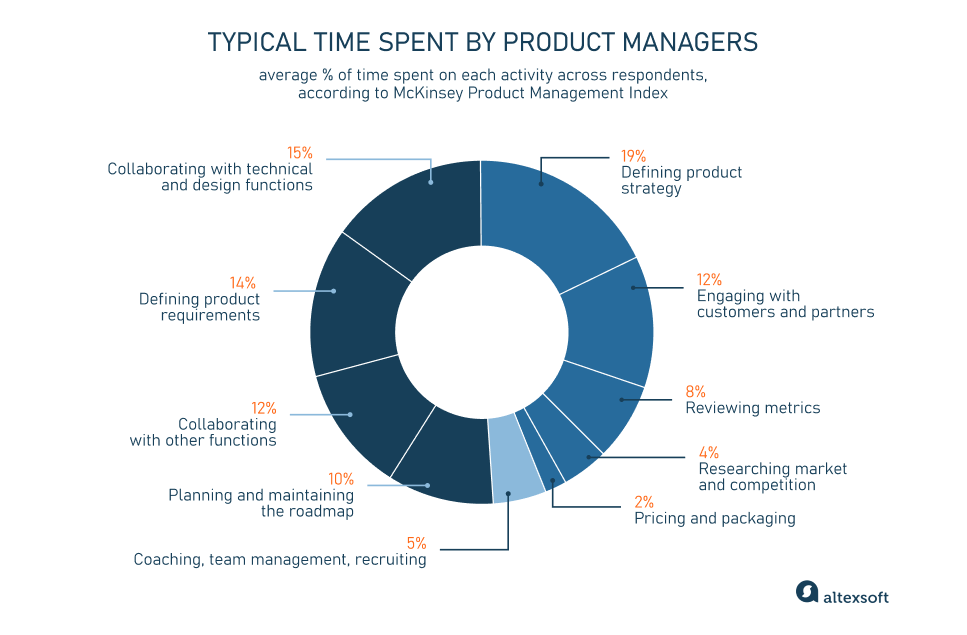
Product manager's activities according to McKinsey Product Management Index
Product manager deliverables
The deliverables are the outputs that a product manager is responsible for producing when working on the project—often through cooperation with other teams:
- product vision ( including mock-ups, demos, or walkthroughs) to define the idea of what a product should be, why it has to be created, and for whom;
- marketing research reports and user personas to analyze competition, describe the target consumers, and define the product/market fit hypotheses;
- product strategy and roadmaps to outline the development process, roles, milestones, and KPIs;
- product requirements that list essential features;
- execution metrics dashboards to monitor the development process;
- testing reports that help discover flaws and improvement opportunities;
- marketing and pricing strategy to plan the product launch and sales; and
- product metrics dashboard to monitor product success.
To cope with such a workload, product managers use various tools that are also worth mentioning.
Product management software
Just like project management tools, product management digital helpers assist with planning and monitoring resources, managing workflows, tracking productivity, collaborating, and exchanging information. However, since product managers have a wider range of responsibilities, they often use more diverse software in their daily routine:
- communication tools, including email, messaging, and web conferencing software (e.g., Outlook, Gmail, Zoom, Skype, Slack, etc.);
- road mapping software (e.g., Wrike, ProductPlan, Aha!, etc.);
- issue-tracking tools (e.g., Jira, Bug Tracker, Bugzilla, etc.);
- customer feedback and survey software (e.g., SurveyMonkey, Typeform, Usersnap, etc.);
- business intelligence tools (e.g., Power BI, Tableau, Qlik, etc.), and so on.
Depending on the scope of work and personal preferences, product management software can also include presentation platforms, notetaking tools, designer software, and more. Luckily, some comprehensive tools such as Jira or Wrike provide functionality that covers multiple workflows—plus numerous integration opportunities to connect to other systems.
Product management process, concepts, and activities
Tasks in product management cascade from strategic to tactical. The whole process involves
- vision development,
- market research,
- strategy development,
- execution,
- marketing and sales, and
- metrics tracking.
Each of the stages may include inbound and outbound activities. A product manager supervises the execution of these activities rather than personally engaging in them.
Inbound activities focus on product development and include defining vision and strategy, product development, testing, and launch.
Outbound activities are oriented toward the marketing and sales of a product. This covers branding, sales, and analyzing customer feedback.
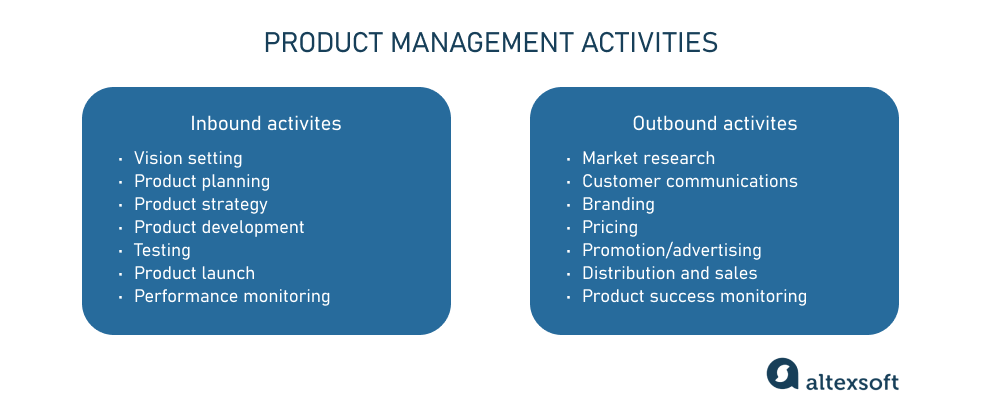
Inbound and outbound product management activities
To get a complete understanding of the process, let’s discuss each product management stage one by one.
Vision development
Product vision is a significant part of product management. If we were to compare product management to a road, the vision is both a road sign and a destination. It defines the final product and shows the direction to achieve it. The vision can be articulated by brainstorming or it may be based on a backlog of ideas. It’s not a strategy of product development yet, but it serves as the starting point. Strategy development begins during idea management when a team discusses a new product.
When developing the vision, a product manager sets the goals for the product and defines specifications. A well-defined product vision answers the following questions:
- What is the user persona (personas) for the product?
- Which problems will the product solve?
- How can we measure the success of the product?
Geoffrey Moore, in his book Crossing the Chasm, suggests using the following template for the product vision definition.

Product vision statement template. Source: ProdPad
Geoffrey Moore also recommends keeping the vision short. As he puts it, “If one cannot test the product vision with an elevator pitch, then it is not ready yet.” For example, Amazon's vision is “to be Earth’s most customer-centric company, Earth’s best employer, and Earth’s safest place to work.”
Market research and customer understanding
Product managers often compile their market research, marketing activities, competitor analysis, and other market-related insights into a market requirements document (MRD). Learn about this document in detail in our dedicated article.
Market research is a process of information collection, market analysis, and present or potential customers. It comprises comparing similar existing products, studying the competition, and identifying target customer groups.
Obviously, knowing your customer is the basis for creating a successful product. Seventy-six percent of consumers expect companies to understand their needs. Moreover, 84 percent of companies that focused on improving customer experience reported a revenue increase.
A product manager, in cooperation with the product marketing manager, conducts various research to get a deep understanding of potential consumers. This process includes several steps.
Creating user personas means describing fictional characters representing the user types that might have an interest in the future product. In other words, it is a portrait of your ideal customer. User personas can include age, gender, education level, average income, life goals, common problems, spending habits, etc.

Example of a user persona
Identifying customers’ needs is the only way to create and deliver a product that will be in demand. Besides defining specific problems and necessities for a particular product, you can categorize customers according to their four primary requirements: price, quality, choice, and convenience.
Studying customer behavior involves understanding the psychology and motivations of your target audience. That includes knowing how they reason and choose between different alternatives, how they conduct research, how their surroundings influence them, how they react to marketing campaigns, and much more.
Market research can be done by a company (primary research) or taken from an external source (secondary research).
Secondary research involves already produced data that you can find in statistical databases, journals, online sources, etc.
Primary research is adapted to a company’s needs and can be qualitative or quantitative. Qualitative research focuses on defining problems and relevant issues. It incorporates personal interviews, group surveys, and focus groups. Qualitative research provides insight into a problem, identifying wants, needs, and possible pitfalls. Quantitative research is based on data collection and statistical analysis. It allows a product manager to reach a larger audience and gather general information.
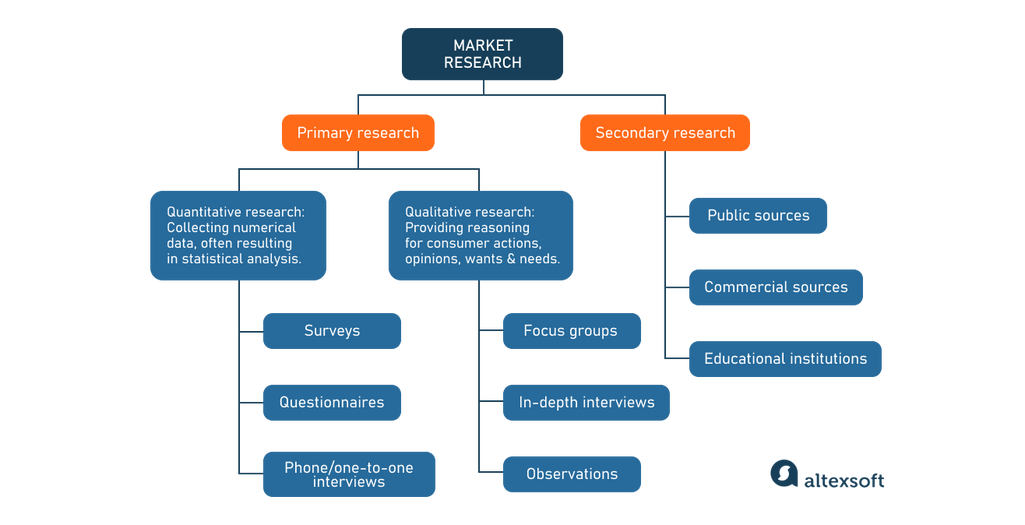
Types of market research
Market research is crucial for product development, both at the execution stage and the marketing and sales stage. With its help, a company can understand what customers want and develop a strategy for creating a product that meets those needs.
Strategy development
Once you have the vision, know the market, and understand customers’ needs, it’s time to formulate a specific product strategy. While a vision defines the goals for a product, a strategy describes how to achieve them and sets the main milestones. It should be a clear and realistic plan for the team working on a product.
An effective product strategy defines the main features of a product, users and their needs, and KPIs that must be met.
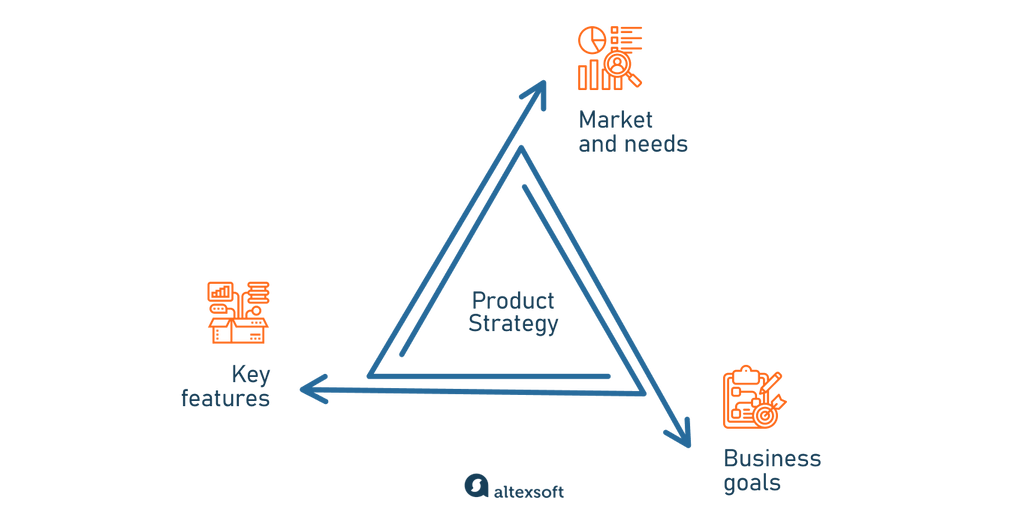
Product strategy elements
Product strategy is typically documented in a written roadmap form that would allow a team to control the work at all stages. A roadmap is a tool that provides a framework for a team with a timeline and specific actions, illustrating the vision, goals, and the current state of product development. Сheck out the video below, where we explain a product roadmap in a nutshell.
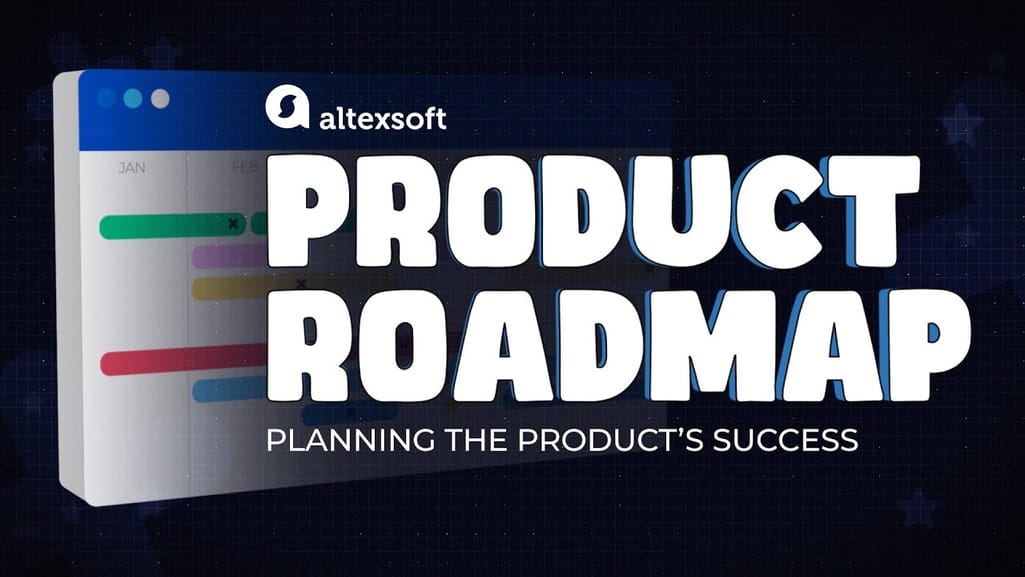

Product roadmap in a nutshell
You can read our dedicated article if you want to learn more about strategic roadmaps, their types, and how to build one.
A good roadmap is clear and serves as a visual guideline for all members of the team. There are different roadmap templates, and their formats depend on the number of products (a single or multiple product roadmap) and aspects of product development (goal- or feature-oriented). However, any roadmap must depict the current state of things, the next steps, and group the items by the sequence of their implementation. Roadmaps can also be internal or external.
An internal roadmap is used on a company level. It shows the vision, short- and long-term goals, and connected processes. Teams that work at different stages of product development can track the timeline and stay aware of upcoming actions. A product manager and a CEO use an internal roadmap to monitor the progress.
An external product roadmap is usually less complicated and is created for stakeholders or shareholders, potential and existing customers, investors, etc.
Prioritization is important at the stage of roadmap preparation. The objectives and activities must range from the most to the least important.
Execution
During the execution stage, a product team works on the software itself. The main phases of this stage are product development, MVP release, testing, and analyzing customer feedback. All along the execution stage, a product manager controls the implementation of the roadmap and participates in accompanying activities.
Product development. Product development starts with defining technical specifications, making prototypes, and a mockup design. While the UX team normally covers these activities, a product manager can be involved in writing technical specifications. The product manager's primary goal is to identify what the users want and communicate this information to the development team and the project manager.
For this purpose, they conduct focus groups and personal interviews with potential customers. The results of these activities allow a product manager to prioritize the necessary and unnecessary features. They write product-related documents, for example, a product requirement document (PRD) and a functional specifications document (FSD).
You can learn more about software documentation practices in our dedicated article.
MVP release and testing. One of the core responsibilities of a product manager is to define the minimum viable product (MVP) and make sure it serves its purpose. When the MVP is released, a product manager sets up a feedback collection mechanism, gathers the feedback, and alters product requirements based on user input. Sixty percent of product managers admit that their best ideas came directly from customer feedback.
A/B testing is one of the most common evaluation techniques. The main idea behind the practice is to choose the product features that are more useful to the customers. A product manager defines testing scenarios with a UX specialist, tracks results, and communicates the changes to the project manager and/or development team.
User acceptance testing (UAT) is conducted in different development stages to test product usability. UAT helps analyze how users interact with the product, and it also discovers flaws, checks for agreement with business requirements, and so on.
Analyzing customer feedback. To conduct successful tests, a product manager sometimes develops a relationship with potential customers, ensuring they will be honest about the usability of a product. While testing, user reaction and customer feedback are analyzed. Once the testing is complete and the results are compiled, a product manager has to convey all of that to a project manager. This way, the developers can prepare the software for launch or introduce changes to the existing product.
Marketing and sales
Once the product is completed, it’s time to enter the market. At this stage, marketing and launch plans must be finalized, and the sales teams are trained to start distribution. The three critical aspects of a successful product launch are
- building customer awareness with the help of various marketing campaigns and promotional activities;
- defining pricing strategy based on the product’s value and market competition; and
- choosing the most effective release timing considering customer readiness, performance of other existing products, competitors’ launches, etc.
A full-fledged marketing strategy involves a lot of pre-launch activities aimed at creating a buzz around your product even before it appears on the market. They include advertising through different media channels, pre-launch giveaways, creating high-quality, SEO-optimized content, etc. They all have to focus on the specific target group of customers that was predefined during previous market research.
Through the whole process, the product manager delivers an operating plan, which aims at tracking the growth of a product in the market. We will talk about this process and specific metrics in the next section.
In startups and smaller companies that don’t have a separate product marketing manager position, the product manager may have more responsibilities at this stage. In this case, the product manager can be involved in the following processes:
- writing business and use cases,
- configuring the product launch plan and distribution models,
- specifying the target market,
- defining the pricing strategy, and
- setting sales support and required tools.
In larger businesses, these activities are usually distributed among product, sales, and marketing executives.
Tracking product metrics
After the product launch, the product manager monitors its progression and analyzes data to understand the success of a product. Key metrics to track can be organized into several main groups:
- the financial metrics for identifying revenue, such as monthly recurring revenue that shows the revenue related to the product in one month;
- metrics reflecting user engagement, like session duration measuring how long the product was used;
- metrics demonstrating user interest, i.e., retention rate that calculates the number of consumers who stayed loyal to the company after a certain period;
- metrics that measure the product popularity, like the number of sessions per user showing how often the site is used; and
- metrics showing user satisfaction, such as the net promoter score that defines the number of customers likely to recommend the product.
We have a detailed article about key product management metrics and KPIs.
It's definitely not enough to just choose the metrics to follow and collect information. What matters is the further analysis and the valuable insights that can be obtained from data—to influence decision-making later. The results of such analysis will show the management team how well the product performs and if any changes are necessary—be it adding new features, adjusting the sales strategy, or updating the marketing campaign.
Product team structure and roles
Depending on the size of the company and its stage of maturity, the role of a product manager can vary greatly. In a startup, this position can be held by a project manager or a product owner, which we discuss below. In small companies, the product manager is likely to be a jack-of-all-trades with a broad range of responsibilities, including marketing, pricing, and even sales.
The roles in a bigger and more mature company, however, are usually more distinctly defined and have a narrower function scope. Also, as the business grows and starts developing multiple products, the need for a chief product officer arises to oversee the entire product portfolio.
The product manager is part of the product team that includes several players, including those at the management level. Usually, there are three: a product manager, a project manager, and a product marketing manager. Product development can also be influenced by stakeholders, and besides that, there’s also a business analyst—someone who translates stakeholders’ business requests into development tasks for the tech team.
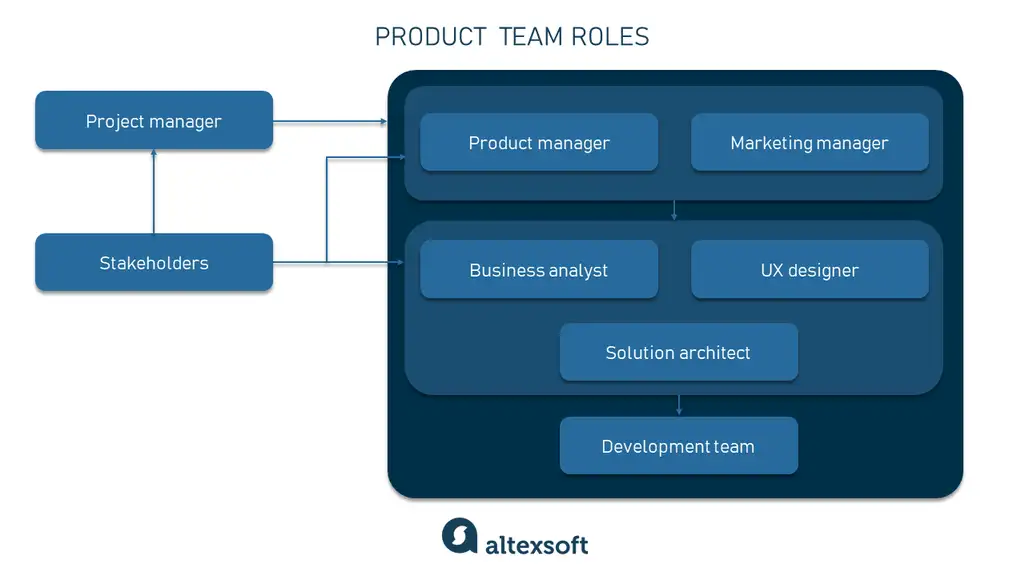
Roles in a product management team
Each manager has their own responsibilities, limited to their sphere of concern. The product manager’s role is much broader and includes activities on every level. Let’s define the functional scope of the other positions to understand a product manager’s role better.
Project manager vs. product manager
We earlier explained the differences between product and project management. Let’s sum up the main distinctions and how the two roles may intersect.
A project manager is responsible for a single part of a product life cycle—product development. They ensure the project follows a timeline and fits a budget. Meanwhile, the product manager’s responsibilities are more high-level as they set the overall vision, develop the strategy, and identify and prioritize the requirements.
While responsible for different aspects of product development, these roles are still complementary and have several overlapping functions:
- working on project documentation,
- controlling the development process,
- communicating with stakeholders and clients, and
- reporting the stages of the work to the clients and/or stakeholders.
The product managers also cooperate closely with other departments, such as marketing and sales. Project managers don’t do that, focusing primarily on working with the development team.
Product marketing manager vs. product manager
Product marketing managers are in charge of the product's commercialization, branding, and positioning. They conduct market research, determing packaging style, supervise sales team training, and plan promotional activities and events. Typically, they are responsible for
- defining user persona and learning about the customers,
- creating the product’s marketing strategy,
- communicating the product’s value to the market, and
- developing sales tools for a product.
Product managers' functions are much wider as they have the ultimate responsibility for product creation—with marketing being a part of it. As we've already said, they work together with a product marketing manager to create a clear understanding of potential customers.
Shared responsibilities of product marketing and the product managers include:
- pricing,
- customer feedback collection,
- market research,
- development of sales tools, and
- analysis of sales data.
But, again, the specific range of tasks depends on the company size. For example, studies showed that 69 percent of product managers working in companies with less than 1000 people conduct user research.
Product owners vs. product managers
While these two terms are often used interchangeably, there is a difference. The concept of product owner comes from Scrum—an Agile framework for developing solutions for complex problems. According to the Scrum Guide, the product owner “is accountable for maximizing the value of the product resulting from the work of the Scrum Team.”
The product owners work internally, are deeply involved in the technical process, and collaborate closely with tech teams. They maintain the backlogs, define iterations, create acceptance criteria, lead backlog grooming, accept user stories, and ensure they are “ready.” However, they work with the product manager on release planning, feature definition, and defect management. So, the product owner’s role is more tactical and focused on short-term tasks than the product manager’s.
This position can seem more similar to the project manager's since both oversee the development teams. Still, the product owner is more detail-oriented and only exists as part of Scrum teams. The project manager must coordinate multiple teams working on complex or risky projects, manage the documentation, and sometimes track team progress.
How to become a good product manager
A product manager frequently doesn’t have a degree in product management. Often, it’s someone with a background in marketing, user experience design, or software engineering. The main element here is not the experience per se but the domain knowledge—the more you know about a particular market and its customers, the better you can lead your product to success.
Product manager background
Here are our recommendations for people of different backgrounds to help you close the gap and get into product management.
If you’re a techie. A product manager is a leadership position, so to become one, you should lead and engage in fateful decisions about a product. Suggest new features and the means to implement them. Support your ideas with research using focus groups. Start your side project or startup. Besides, any project can be a case study to show your future employees or current managers.
If you’re coming from marketing. Although the activities of product and marketing managers often coincide, note this big difference—a product manager is heavily involved in product development. Your main objectives will be learning to understand development workflows, technology and successful communication with the engineering team.
Since, on many projects, marketing professionals aren’t expected to engage directly with the tech side, you’ll have to initiate conversations and apply the skills you already have. Knowing the issues that customers face every day, you can offer your solutions and estimate how much time and engineering effort solving their problems will take.
If you’re a designer. Besides acquiring the necessary technical and marketing skills, you would probably experience a notable change in your daily schedule, diversity of tasks, and overall work rhythm. Suelyn Yu, a UX designer who became a product manager, notes that as a designer, she had a “maker’s schedule”—most of her work was unscheduled, and she was free to plan her tasks independently.
If you’re in a similar position, use this opportunity to understand the decisions behind the changes you’re asked to create. Ask questions and request access to client feedback and user interviews if you don’t already have it.
Product manager skills
Product managers need a mix of hard and soft skills to excel in their positions. Let's recap the primary hard skills that were mentioned earlier:
- vision and strategy development,
- team and stakeholder management,
- resource allocation,
- market research,
- domain expertise,
- understanding UX,
- analyzing customer feedback, and
- tracking product metrics.
Ultimately, product managers need to be business savvy, have technical knowledge, and be proficient in marketing. However, not everybody realizes the importance of soft skills and emotional intelligence for this position.
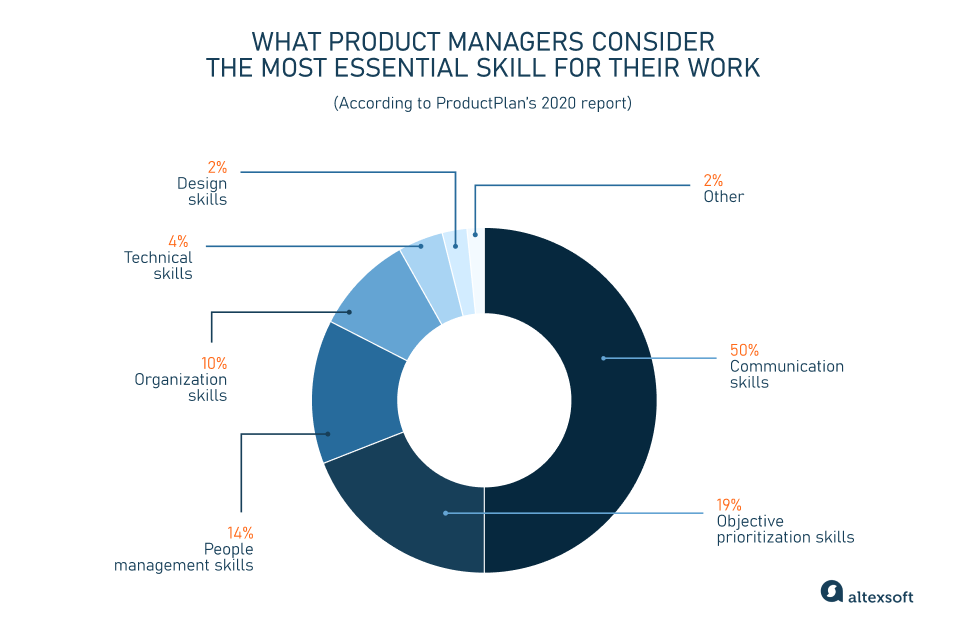
Product manager’s skillset according to Productplan’s report
A big part of a product manager’s responsibilities is related to communication, i.e., coordinating the development team, interviewing customers, informing executives, connecting with stakeholders, etc. So, excellent relationship management skills are a must-have for this role. Product managers should inspire people, resolve inevitable conflicts, and balance the interests and demands of all stakeholders, keeping everyone motivated and satisfied.
Some specific character traits that make the best product managers are
- empathy—to understand customers and team members better;
- self-awareness—to stay objective and avoid involving their own interests in business;
- self-management—to be disciplined and organized and organize others; and
- stress tolerance—to manage emotions and stay calm under constant pressure.
Besides all that, a product manager is expected to have a strong “intelligence and problem-solving ability,” as noted in a classic essay by Ken Norton, How to Hire a Product Manager. He emphasizes that he would prefer a “wickedly smart, inexperienced PM over one of average intellect and years of experience.” He also mentions technical skills, strong intuition and creativity, leadership skills, and the ability to channel multiple points of view as the most important characteristics.
Product management certification
If you feel you have the necessary skill set to become a product manager but lack theoretical knowledge or just want to add more value to your resume, you can take a product management course. This will help you get in-depth industry comprehension and develop your expertise.
Industry-recognized product management certifications can be obtained from AIPMM, Product HQ, Product School, Pragmatic Institute, or other renowned institutions.
Mitigating failure with strategic product management
According to Nielsen statistics, each year, over 30,000 new products are launched, and 85 percent of them fail. While there are many reasons for this, one of the most significant is that too many products are not thoroughly prepared for the market. Neglecting one aspect of product development and focusing excessively on the other usually leads to financial losses. Proper product management makes it possible to evade such consequences and increase the chances of the product succeeding in the market.

Maria is a curious researcher, passionate about discovering how technologies change the world. She started her career in logistics but has dedicated the last five years to exploring travel tech, large travel businesses, and product management best practices.
Want to write an article for our blog? Read our requirements and guidelines to become a contributor.
